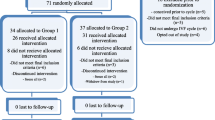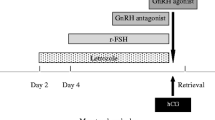Abstract
Objective
To compare fertilization, implantation and pregnancy rates in donor oocyte cycles triggered for final oocyte maturation with either human chorionic gonadotropin (hCG) or gonadotropin releasing hormone (GnRH) agonist in the same donor population in two sequential stimulation cycles.
Design
Prospective randomized cross-over trial.
Setting
Private infertility clinic.
Patient(s)
Eighty-eight stimulation cycles in 44 egg donors.
Interventions
Controlled ovarian hyperstimulation (COH) with GnRH antagonist protocol triggered with hCG or GnRH agonist (leuprolide acetate 0.15 mg) in the same egg donors in two consecutive cycles.
Main outcome measure(s)
The primary outcome measure was the proportion of mature and fertilized oocytes per donor cycle. Secondary outcome measures were implantation and pregnancy rates in the recipients and incidence of ovarian hyperstimulation syndrome (OHSS) in oocyte donors.
Result(s)
The proportion of mature oocytes, fertilized oocytes and mean embryo scores were comparable between the two triggering agents. While implantation (36.53% vs, 32.93%), pregnancy (69.08% vs. 68.81%) and clinical pregnancy (41.3% vs. 40.2%) rates were comparable for the groups, the incidence of OHSS was significantly lower in GnRH than in hCG triggered cycles.
Conclusion(s)
Fertilization, implantation and pregnancy rates from donor oocytes stimulated with GnRH antagonist protocol were identical for donor cycles triggered with hCG and GnRH agonist. GnRH antagonist triggering in egg donors was associated with lower rates of OHSS.

Similar content being viewed by others
References
Shapiro BS, Daneshmand ST, Garner FC, Aquirre M, Ross R, Morris S. Effects of the ovulatory serum concentration of human chorionic gonadotropin on the incidence of ovarian hyperstimulation syndrome and success rates for in vitro fertilization. Fertil Steril. 2005;84:93–8.
Itskovitz-Eldor J, Kol S, Mannaerts B. Use of a single bolus of GnRH agonist triptorelin to trigger ovulation after GnRH antagonist ganirelix treatment in women undergoing ovarian stimulation for assisted reproduction, with special reference to the prevention of ovarian hyperstimulation syndrome: preliminary report: short communication. Hum Reprod. 2000;15:1965–8.
Shapiro BS, Daneshmand ST, Garner FC, Aguirre M, Thomas S. Gonadotropin-releasing hormone agonist combined with a reduced dose of human chorionic gonadotropin for final oocyte maturation in fresh autologous cycles of in vitro fertilization. Fertil Steril. 2008;90:231–3.
Griesinger G, Diedrich K, Devroey P, Kolibianakis EM. GnRH agonist for triggering final oocyte maturation in the GnRH antagonist ovarian hyperstimulation protocol: a systematic review and meta-analysis. Hum Reprod Update. 2006;12:159–68.
Orvieto R, Rabinson J, Meltzer S, Zohav E, Anteby E, Homburg R. Substituting HCG with GnRH agonist to trigger final follicular maturation—a retrospective comparison of three different ovarian stimulation protocols. Reprod Biomed Online. 2006;13:198–201.
Griesinger G, Kolibianakis EM, Papanikolaou EG, Diedrich K, Van Steirteghem A, Devroey P, et al. Triggering of final oocyte maturation with gonadotropin-releasing hormone agonist or human chorionic gonadotropin. Live birth after frozen-thawed embryo replacement cycles. Fertil Steril. 2007;88:616–21.
Shapiro BS, Daneshmand ST, Garner FC, Aguirre M, Ross R. Comparison of human chorionic gonadotropin and gonadotropin-releasing hormone agonist for final oocyte maturation in oocyte donor cycles. Fertil Steril. 2007;88:237–9.
Bodri D, Guillén JJ, Galindo A, Mataró D, Pujol A, Coll O. Triggering with human chorionic gonadotropin or a gonadotropin-releasing hormone agonist in gonadotropin-releasing hormone antagonist-treated oocyte donor cycles: findings of a large retrospective cohort study. Fertil Steril. 2008;91:365–71.
Steer CV, Mills CL, Tan SL, Campbell S, Edwards RG. The cumulative embryo score: a predictive embryo scoring technique to select the optimal number of embryos to transfer in an in-vitro fertilization and embryo transfer programme. Hum Reprod. 1992;7:117–9.
Humaidan P, Bredkjaer HE, Bungum L, Bungum M, Grøndahl ML, Westergaard L, et al. GnRH agonist (buserelin) or hCG for ovulation induction in GnRH antagonist IVF/ICSI cycles: a prospective randomized study. Hum Reprod. 2005;20:1213–20.
Eldar-Geva T, Zylber-Haran E, Babayof R, Halevy-Shalem T, Ben-Chetrit A, Tsafrir A, et al. Similar outcome for cryopreserved embryo transfer following GnRH-antagonist/GnRH-agonist, GnRH-antagonist/HCG or long protocol ovarian stimulation. Reprod Biomed Online. 2007;14:148–54.
Acevedo B, Gomez-Palomares JL, Ricciarelli E, Hernández ER. Triggering ovulation with gonadotropin-releasing hormone agonists does not compromise embryo implantation rates. Fertil Steril. 2006;86:1682–7.
Engmann L, DiLuigi A, Schmidt D, Nulsen J, Maier D, Benadiva C. The use of gonadotropin-releasing hormone (GnRH) agonist to induce oocyte maturation after cotreatment with GnRH antagonist in high-risk patients undergoing in vitro fertilization prevents the risk of ovarian hyperstimulation syndrome: a prospective randomized controlled study. Fertil Steril. 2008;89:84–91.
Bodri D, Guillén JJ, Polo A, Trullenque M, Esteve C, Coll O. Complications related to ovarian stimulation and oocyte retrieval in 4052 oocyte donor cycles. Reprod Biomed Online. 2008;17:237–43.
Acknowledgements
The authors thank Nevin Demir, Handan Canca and Cyprus Yasam Hospital IVF team for the data collection.
Author information
Authors and Affiliations
Corresponding author
Additional information
This is the first prospective randomized cross-over study supporting the hypothesis that GnRH agonist is an effective alternative to hCG for the final oocyte maturation in oocyte donor cycles and should be the method of choice, especially for donors with evident risk factors for OHSS.
Rights and permissions
About this article
Cite this article
Sismanoglu, A., Tekin, H.I., Erden, H.F. et al. Ovulation triggering with GnRH agonist vs. hCG in the same egg donor population undergoing donor oocyte cycles with GnRH antagonist: a prospective randomized cross-over trial. J Assist Reprod Genet 26, 251–256 (2009). https://doi.org/10.1007/s10815-009-9326-6
Received:
Accepted:
Published:
Issue Date:
DOI: https://doi.org/10.1007/s10815-009-9326-6




